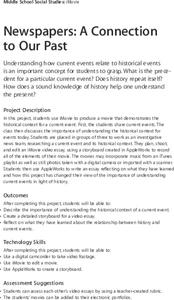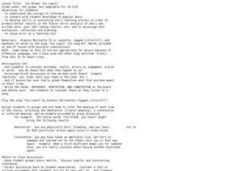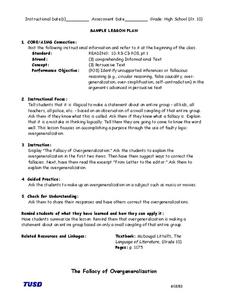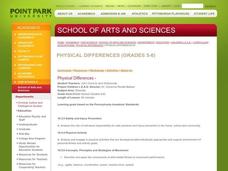Curated OER
Newspapers: A Connection to Our Past
Students research the historical context for a currents event. They create an iMovie that explains why it is important to explain the history behind a current event.
Curated OER
You Bleed, You Learn?
Jump back into the 90s with Alannis Morissette's song "You Learn." After hearing the song, small groups analyze the lyrics and write an essay about a mistake they've learned from. Use the example sentences to identify the denotative and...
Curated OER
Basic Writing Skills
Learners listen to story A Mason-Dixon Memory, by Clifton Davis, and complete worksheets about the story. The worksheets are embedded in the plan. This activity provides good reading comprehension practice for young readers.
Curated OER
Boat Safety and Water Sports - Lesson 9 - Conditioning for Water Skiing
It takes muscle strength and muscle endurance to get up on a water ski or wake board, and to stay up. Lesson 9 out of this 22 lesson plan unit is about conditioning. A resource link at the bottom of the page allows you to view all the...
Curated OER
Comprehending Informational Text
Do you know what a fallacy is? Discuss this term and its meaning with your class. Then, talk about why making generalizations about a large group of people isn't the best thing to do. As a group, study the included letter excerpt. It...
Curated OER
Sound
Third graders explore sound. They describe sounds in terms of their properties and explain how sounds are made. Students discuss how various sounds sound to their ears and how sound travels in waves.
Curated OER
Computation with Fractions
Upper graders are introduced to the topic of fractions and percentages. In groups, they discuss real world situations in which fractions are present, and they complete a worksheet solving problems with common and uncommon denominators....
Curated OER
Figurative Language: Simile and Metaphor
What is figurative language? Introduce your young learners to the most popular forms of figurative language: the simile and the metaphor. Start by reading "Willow and Ginkgo" by Eve Merriam, and identify where similes are used. Then look...
Curated OER
Geography: Puerto Rico
Take a trip to Puerto Rico! Learners engage in a web quest, identify Puerto Rico on the map, and gather information related to physical features and cultural factors. Their efforts culminate when they design a brochure comparing the...
Curated OER
What is Sound?
Second graders discuss sound and describe them. For this investigative lesson students observe sound through their eyes, bodies and ears.
Curated OER
Pin Grab
Pin Grab is a basic tag game. Each player has a clothes pin attached to the back of their shirt. Other players try to grab them off. If a player has their pin grabbed off they must do a physical activity, such as jumping jacks to get...
Curated OER
Flip Libdub
How do you translate songs from English to Spanish? Have your intermediate learners work in groups to choose a song, translate it, and record themselves singing the lyrics. Provide your class with more time or recommend some out of class...
Curated OER
Dancing Opposites (Size)
Students create movements that illustrate opposites. In this opposites instructional activity, students discuss what opposites do for writing and relate to dance. Students make movements based on their opposites.
Curated OER
Dance Showing Science Contexts of Movement: States of Matter
Fifth graders dance in different ways to show movement of states of matter. In this matter lesson plan, 5th graders make connected shapes with a partner, make flowing movements, travel rapidly, and more.
Curated OER
Spanish Body Parts and Vowels
Play Simon Says with your young Spanish learners! First teach them body parts in Spanish, and then get them up and moving with this short activity!
Curated OER
Biopoem
Reinforce the actions, emotions, and characteristics that determine what a character is like by having your middle schoolers create a biopoem using the model presented here. You could engage them first by having them write a poem about...
Novelinks
The Cure: Guided Imagery
Prepare class members for a discussion of Sonia Levitin's dystopian novel The Cure, by leading them on a guided imagery exercise designed to encourage visualization of written descriptions.
Curated OER
Nervous System
Get to know the body's central nervous system through an engaging game of nervous system telephone. But this isn't your average game of telephone. Here, pupils must find a way to communicate a message to the brain without speaking....
Curated OER
History of Aaron Copland
Third graders study the history of Aaron Copland, the famous American composer. They dance to the song Hoe-Down composed by Aaron Copland.
Curated OER
Compositional Techniques: Are There Similarities Between
Students recognize how chromatic scales create tension and pentatonic scales create relaxation as compositional techniques used to create tonality. Also, students aurally recognize the use of mixed or alternating meter as a means of...
Curated OER
Freedom, Power and the People
Learners analyze how social change has affected artistic expression and popular culture. the explain the influence of media on contemporary American culture.
Curated OER
Diversity
Students access prior knowledge of the five senses and relate to students with disabilities. In this people with disabilities instructional activity, students research and use a Venn diagram to compare and contrast famous people and...
Curated OER
The Listening Walk
Students play instruments that reflect sounds in the story: hoots, toots, creaking, shrieks, clacking, crunching, whooshing, etc. They make vocal sounds from the story: whispered, sniffled, sigh, giggled, croaked, laughed. The...
Curated OER
What I Did On My Summer Vacation
Students improvise then compose and notate melodies with appropriate accompaniments that are inspired by events that transpired during their summer vacations. Requires a networked keyboard lab.

























